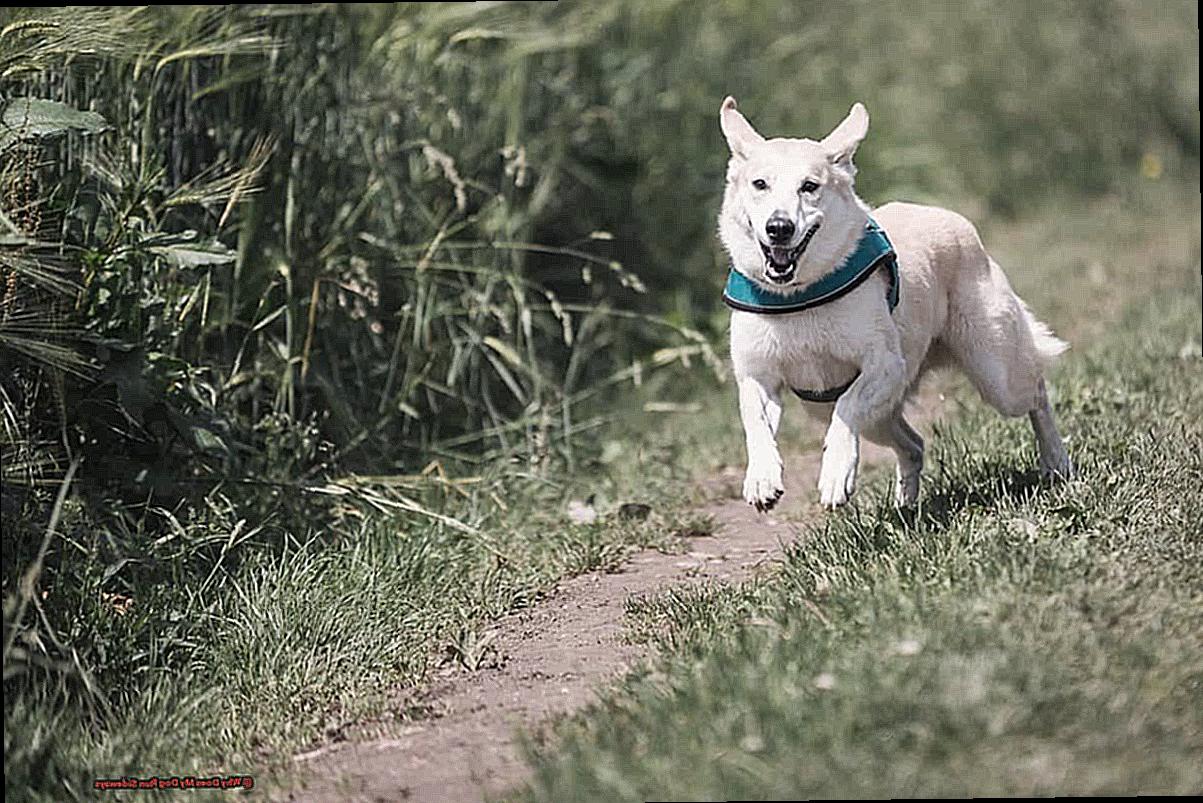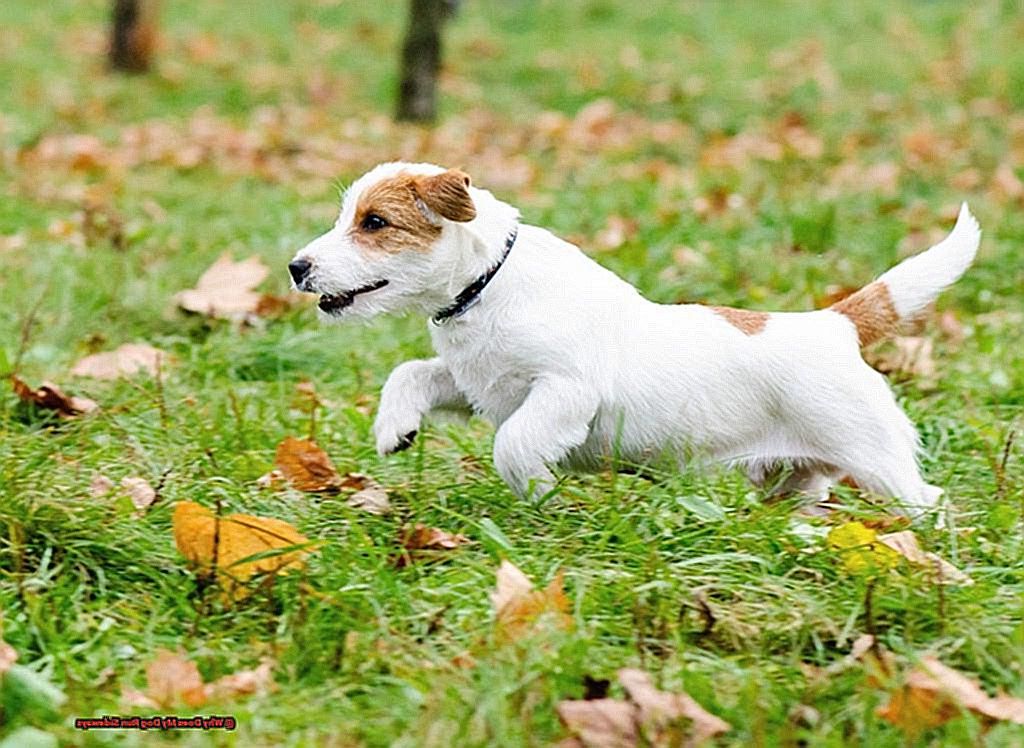Why Does My Dog Run Sideways?
Ever seen your dog running sideways?
Contents
- 1 Why Does My Dog Run Sideways?
- 2 The Different Types of Sidestepping in Dogs
- 3 Common Reasons for Dogs Running Sideways
- 4 How to Identify If Your Dog’s Sidestepping Is a Cause for Concern
- 5 Addressing Underlying Health Issues That May Contribute to Sidestepping
- 6 Training and Socialization Techniques to Correct Habitual Sidestepping
- 7 Neurological Conditions and Their Impact on a Dog’s Gait
- 8 Conclusion
It’s not just a funny video, there are reasons behind it. From medical issues to instincts, let’s dive into the world of canine locomotion.
Join me and your furry friend as we explore why dogs run sideways in this blog post.
Why Does My Dog Run Sideways?
As a dog owner, it can be concerning when you notice your furry friend running sideways instead of in a straight line. This behavior, also known as “crabbing” or “sidestepping”, is common among dogs and can be seen in breeds such as French Bulldogs. But why do they do it? In this blog post, we will explore the potential reasons behind this behavior and offer practical solutions for addressing it.
Possible Health Issues
One of the most common reasons for a dog’s sideways running is an underlying health issue. This could include issues with their spine or joints, which can cause discomfort and lead to abnormal movement patterns. For example, hip dysplasia, a condition where the hip joint does not develop properly, can make it difficult for dogs to run straight and result in them running sideways instead. Other injuries or conditions such as sprains, strains, or obesity can also contribute to this behavior.
Breed and Physical Characteristics
French Bulldogs have a unique body structure with short legs and a stocky build, which can affect their gait and make them more prone to sideways running. This is because their body proportions can make it challenging for them to balance and move in a straight line. It’s important for owners of French Bulldogs to be aware of this and take extra precautions when exercising or playing with their dog.
Behavioral Reasons
Some dogs may run sideways as a way to release pent-up energy or express excitement. This behavior can also be seen in puppies who are still learning how to control their movements. If your dog is exhibiting this behavior, it may be a sign that they need more exercise and mental stimulation. Adequate physical activity and mental stimulation can help prevent boredom and reduce the chances of your dog running sideways.
Environmental Factors
Slippery floors or uneven terrain can also contribute to a dog’s sideways running. This is especially true for breeds like French Bulldogs, who have a higher risk of slipping due to their body structure and short legs. It’s important to keep surfaces non-slip and provide a safe environment for your dog to move around in.
The Different Types of Sidestepping in Dogs
If you have a French Bulldog, you may have noticed them doing a little side-to-side dance while walking or running. This behavior, known as sidestepping or crabbing, is not uncommon in Frenchies and can actually be seen in other breeds as well. While it may seem cute or quirky, it’s essential to understand why your dog is sidestepping as it can be an indication of an underlying issue.
Firstly, let’s define sidestepping. It is when a dog takes quick and short steps to the side while moving forward. There are different types of sidestepping that dogs may exhibit, and each type can give clues as to what may be causing the behavior.
Crabbing or sideways gait is the most common type of sidestepping seen in French Bulldogs. It is characterized by the dog moving with one side of its body leading instead of moving in a straight line. This can be caused by structural issues such as hip dysplasia or an injury to the hind legs. If your Frenchie is constantly crabbing, it’s best to consult with a veterinarian to rule out any medical conditions.
Another type of sidestepping is known as “weaving,” where a dog moves side to side while walking or running. This can be a sign of neurological problems or inner ear issues that affect balance. Similarly, some dogs may exhibit “sidewinding,” where they move in a curved pattern while walking or running. This can be seen in dogs with joint problems, muscle weakness, or spinal issues. It’s crucial to observe your dog’s gait closely and take note of any changes or abnormalities.
While some dogs may naturally have a wider stance and appear to move sideways more often, it’s still important to monitor their behavior and consult with a veterinarian if you notice any sudden changes or if the behavior becomes more frequent or severe. Early detection and proper treatment can help prevent any underlying issues from worsening.
So, what can you do to help your Frenchie with their sidestepping? Regular exercise and maintaining a healthy weight can go a long way in preventing or alleviating this behavior. Strengthening exercises and physical therapy may also be recommended by a veterinarian in cases where the behavior is caused by structural or muscular issues. Additionally, providing your dog with a supportive orthopedic bed can help alleviate any discomfort and reduce the risk of further injury.

Common Reasons for Dogs Running Sideways
It can be a concerning behavior, especially if it is a sudden change in their gait. But don’t worry, there are several reasons why dogs may run sideways, and it’s essential to understand them to better care for your pup.
One possible reason for this behavior is due to a vestibular disorder. This condition affects the inner ear, causing an imbalance in the dog’s sense of balance and coordination. As a result, they may run in an uncoordinated manner, often with a sideways gait. Other symptoms of vestibular disorder include head tilting, loss of balance, and rapid eye movements. If you notice these signs in your dog, it’s crucial to consult with a veterinarian for proper diagnosis and treatment.
Another common cause of dogs running sideways is hip dysplasia. This is a condition that affects many dog breeds, including French Bulldogs. Hip dysplasia is a malformation of the hip joint, which can cause pain and discomfort in the dog’s hind legs. As a result, your pup may run in a sideways manner to avoid putting pressure on their affected hips. This condition can be managed through medication, physical therapy, and surgery if necessary.
Injuries or pain in the legs or feet can also cause dogs to run sideways. This could be due to sprains, strains, or even fractures. As dogs age, they may also develop conditions like arthritis, which can make running and moving more difficult and lead to a sideways gait. If you suspect your dog has sustained an injury or is experiencing pain in their limbs, it’s best to consult with a veterinarian for proper treatment.
Some dogs may also have a natural tendency to run sideways due to their body structure. For example, breeds like Dachshunds have longer bodies and shorter legs, making it more comfortable for them to move in a sideways motion. Additionally, certain behavior or training issues can also cause a dog to run sideways. For instance, if a dog has been trained to walk on a leash by pulling on the side, they may continue this behavior when running off-leash. This could result in a sideways gait as they are used to pulling towards one direction.
It’s also essential to consider the environment and terrain where your dog is running. Slippery or uneven surfaces can cause dogs to lose their balance and run sideways for stability. As a responsible pet owner, it’s important to ensure that your dog is running on safe and suitable surfaces to prevent any potential injuries or discomfort.
How to Identify If Your Dog’s Sidestepping Is a Cause for Concern
While some dogs naturally have a “sideways” gait, it can also be a sign of an underlying issue. In this blog post, I will discuss how you can identify if your dog’s sidestepping is a cause for concern and what to do about it.
First, let’s talk about what exactly we mean by “sidestepping” in dogs. It is a common behavior where the dog moves with one side of its body leading instead of moving in a straight line. You may have also heard it referred to as “crabbing” or “sideways running.” While this behavior can be normal for some dogs, it can also be a red flag for potential health issues.
The first step in identifying if your dog’s sidestepping is concerning is to observe how often they do it and how severe the behavior is. If your dog only runs sideways occasionally and it doesn’t seem to affect their movement or energy levels, it may just be a natural quirk. However, if you notice the behavior becoming more frequent or intense, it could be a sign of an underlying issue.
Next, consider the context in which your dog is sidestepping. Is it only happening during playtime or does it occur while walking as well? Are they avoiding certain areas or objects while running sideways? Understanding the triggers for this behavior can give insight into whether it is just playfulness or if there could be a physical issue.
It is also important to take note of any accompanying symptoms that your dog may be exhibiting. Are they limping or showing signs of discomfort? Is there any change in their appetite or energy levels? These could be red flags that there may be an underlying medical condition causing the sidestepping.
There are several potential reasons why your dog may be running sideways. It could be due to an injury or pain in their limbs, hip dysplasia, obesity, or even certain neurological conditions. If you notice any of these concerning factors, it is best to consult with a veterinarian for a thorough examination. They will be able to determine the underlying cause and provide proper treatment.
However, if your dog’s sidestepping seems to be a natural behavior and does not cause any discomfort or other symptoms, there may not be a cause for concern. Some dogs simply have a unique way of moving and it is important for owners to recognize and accept their individual quirks.
Addressing Underlying Health Issues That May Contribute to Sidestepping
“French bulldogs are known for their adorable and sometimes comical sideways running. But what if your beloved Frenchie’s sidewards gait is not just a cute quirk, but a sign of an underlying health issue? As a responsible pet owner, it’s essential to be aware of potential health problems in your furry friend and take the necessary steps to address them. In this blog post, we’ll dive into the importance of addressing underlying health issues in French bulldogs and how regular check-ups and a healthy lifestyle can help keep your pup happy and healthy.
First and foremost, it’s crucial to understand why your Frenchie may be running sideways. One common cause is hip dysplasia, a condition where the hip joint does not form properly, resulting in misalignment and discomfort when moving. This can lead to compensatory movements, such as running sideways. Another potential culprit is patellar luxation, where the kneecap dislocates from its normal position, causing pain and abnormal movement patterns.
Another health issue that may cause your Frenchie to run sideways is intervertebral disc disease. This condition involves the degeneration of discs between the vertebrae in the spine, leading to nerve compression and pain. These are just a few examples of underlying health issues that can affect your dog’s gait and cause them to run sideways.
So how can you determine if your Frenchie’s sidestepping is a cause for concern? It’s essential to pay attention to frequency and triggers. If your dog only runs sideways occasionally during play or when excited, it may just be a harmless quirk. However, if it becomes more frequent or occurs during regular activities like walking or running, it’s best to consult with your veterinarian.
Accompanying symptoms are also important to note. Is your dog experiencing any pain or discomfort? Are there any changes in their appetite or energy levels? These can be signs of underlying health issues, and it’s essential to address them as soon as possible.
If you suspect that your Frenchie’s sideways running is a result of an underlying health issue, schedule a visit with your veterinarian. They will be able to conduct a thorough physical examination and possibly perform diagnostic tests to identify any health problems that may be causing the behavior.
Training and Socialization Techniques to Correct Habitual Sidestepping
As a loving French bulldog owner, you may have noticed your furry companion’s tendency to run sideways. While this may seem like an adorable quirk, it is important to address this behavior to ensure your dog’s safety and well-being. In this blog post, we will explore how to correct the habit of sidestepping in French bulldogs and provide valuable insights based on research and personal experiences.
First and foremost, it is important to understand why French bulldogs may develop this habit. Like most breeds, Frenchies have a natural instinct to run in a straight line. However, some may develop a habit of running sideways due to various reasons such as lack of proper training, improper socialization, or underlying health issues. As responsible pet owners, it is our duty to address these reasons and help our dogs develop proper running behavior.
The key to correcting sidestepping in French bulldogs is consistent training. It is important to start training your Frenchie from a young age and use positive reinforcement techniques such as treats and praise to encourage straight running behavior. This not only helps them learn proper behavior but also strengthens the bond between you and your dog.
Furthermore, socialization plays a crucial role in a dog’s behavior. It is important to expose your French bulldog to different environments, people, and other dogs at an early age. This helps them learn appropriate social skills and prevents them from developing bad habits like sidestepping.
In addition to training and socialization, teaching basic obedience commands can also be beneficial. Commands such as “heel” or “stay” can help redirect your dog’s attention and keep them focused on running in a straight line. However, it is important to remain patient and consistent with these training techniques. It may take some time for your Frenchie to unlearn their habit of sidestepping, but with regular training sessions and positive reinforcement, they can learn to run straight.
If the habit of sidestepping persists, it is important to consult with a veterinarian. Some dogs may experience underlying health issues such as hip dysplasia or other joint problems that can cause them to run sideways. Identifying and addressing these issues can make a significant difference in correcting your dog’s behavior.
Neurological Conditions and Their Impact on a Dog’s Gait
As dog owners, we all want our furry companions to be healthy, happy, and able to move around freely. However, sometimes we may notice our French Bulldogs running sideways or exhibiting other abnormal movements. This can be a cause for concern, and as an expert on neurological conditions and their impact on a dog’s gait, I’m here to share my knowledge and insights on this topic.
Neurological conditions, which affect the brain, spinal cord, and nerves, can have a significant impact on a dog’s gait. These conditions can cause coordination issues, balance problems, and muscle weakness, leading to abnormal movements such as running sideways. Let’s dive deeper into some of the common neurological conditions that may affect French Bulldogs and their movement.
Degenerative Myelopathy:
This progressive disease affects the spinal cord and is commonly seen in older dogs. It can cause hind limb weakness and poor coordination, making it difficult for dogs to walk or run straight. While there is no cure for degenerative myelopathy, early detection and proper management can help slow down its progression.
Vestibular Disease:
Vestibular disease affects the inner ear and can cause loss of balance and disorientation in dogs. This can result in them running sideways or stumbling while walking. While some cases of vestibular disease may resolve on their own, others may require medication or supportive care from a veterinarian.
Cerebellar Ataxia:
Cerebellar ataxia is a condition that affects the cerebellum, a part of the brain responsible for motor control. It can cause uncoordinated movements, including running sideways or stumbling. French Bulldogs are particularly prone to this condition due to their brachycephalic skull shape, which can put pressure on the cerebellum.
In addition to running sideways, dogs with neurological conditions may also exhibit other symptoms such as stumbling, falling, or dragging their legs while walking. This can be distressing for both the dog and their owner, and it is crucial to seek veterinary care if these behaviors are observed.
Treatment for neurological conditions may include medication, physical therapy, or surgery, depending on the specific condition and its severity. In some cases, these conditions may be managed but not cured, making it essential for dog owners to work closely with their veterinarian to provide the best care for their furry companion.
Also Read: Are Some Frenchies Smaller Than Others
Conclusion
In conclusion, it is crucial for dog owners to be aware of the potential reasons for their furry friend’s sideways running. While it may seem like a harmless quirk, it can actually be a sign of an underlying health issue or instinctual behavior. By closely observing your dog’s gait and seeking professional guidance if needed, you can ensure that they receive the best care and treatment.
There are various factors that can contribute to dogs running sideways, including health issues such as hip dysplasia, breed and physical characteristics, behavioral reasons, and environmental influences. It is important to address these issues promptly to prevent any further complications or discomfort for your dog.
Fortunately, there are effective training techniques and strategies that can help correct this behavior. From consistent training and socialization to teaching basic obedience commands, you can assist your dog in developing proper running habits. However, if the habit persists or is accompanied by other symptoms, it is crucial to seek veterinary care.
Moreover, neurological conditions can also play a significant role in a dog’s gait and may cause them to run sideways. If you notice any abnormal movements or behaviors in your French Bulldog, it is vital to consult with a veterinarian who specializes in neurological conditions for accurate diagnosis and treatment.
As responsible pet owners, it is our responsibility to ensure that our furry companions are healthy and able to move around comfortably. By understanding the potential reasons behind sideways running in dogs and taking the necessary steps to address them, we can help our dogs live happy and active lives.




